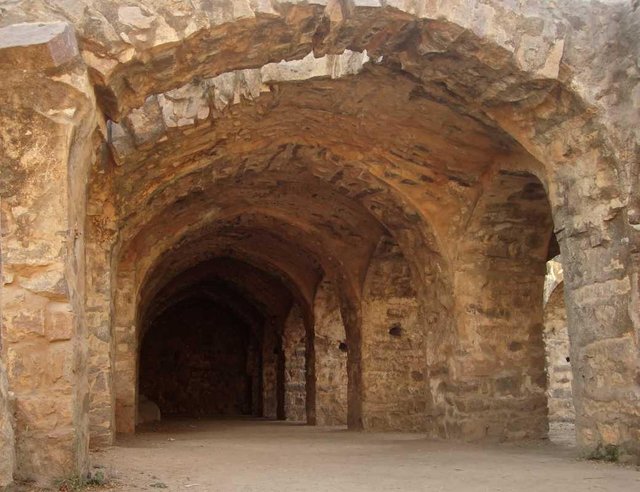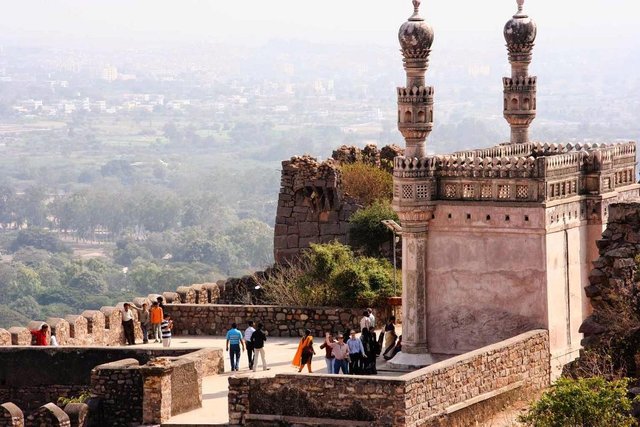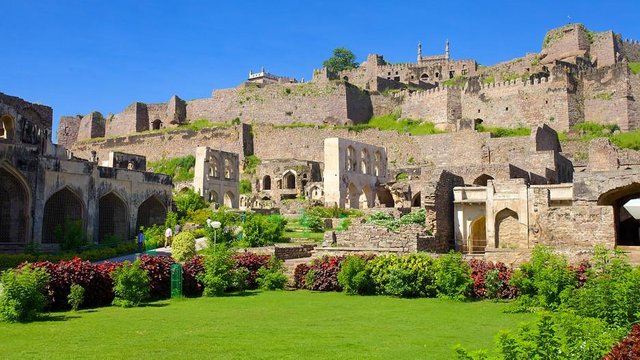golconda fort (india)
Golkonda, also known as Golconda, Gol konda ("Round shaped hill"), or Golla konda, (Shepherds Hill) is a citadel and fort in Southern India and was the capital of the medieval sultanate of the Qutb Shahi dynasty (c.1518–1687), is situated 11 kilometres (6.8 mi) west of Hyderabad. It is also a tehsil of Hyderabad district, Telangana, India. The region is known for the mines that have produced some of the world's most famous gems, including the Koh-i-Noor, the Hope Diamond, Nassak Diamond and the Noor-ul-Ain
Golkonda was originally known as Mankal.[1] Golkonda Fort was first built by the Kakatiya dynasty as part of their western defenses along the lines of the Kondapalli Fort. The city and the fortress were built on a granite hill that is 120 meters (480 ft) high, surrounded by massive battlements. The fort was rebuilt and strengthened by Rani Rudrama Devi and her successor Prataparudra.[2][3] Later, the fort came under the control of the Musunuri Nayaks, who defeated the Tughlaqi army occupying Warangal.[4] It was ceded by the Musunuri Kapaya Nayak to the Bahmani Sultanate as part of a treaty in 1364.[5][6] Under the Bahmani Sultanate, Golkonda slowly rose to prominence. Sultan Quli Qutb-ul-Mulk (r. 1487–1543), sent as a governor of Telangana, established it as the seat of his government around 1501. Bahmani rule gradually weakened during this period, and Sultan Quli formally became independent in 1538, establishing the Qutb Shahi dynasty based in Golkonda.[7][8] Over a period of 62 years, the mud fort was expanded by the first three Qutb Shahi sultans into the present structure, a massive fortification of granite extending around 5 km in circumference. It remained the capital of the Qutb Shahi dynasty until 1590 when the capital was shifted to Hyderabad. The Qutb Shahis expanded the fort, whose 7 kilometres (4.3 mi) outer wall enclosed the city. The fort finally fell into ruin in 1687, after a eight year long siege leading to its fall at the hands of the Mughal emperor Aurangzeb.[9]
The Golkonda Fort used to have a vault where once the famous Koh-i-Noor and Hope diamonds were stored along with other diamonds.[10] Golkonda is renowned for the diamonds found on the south-east at Kollur Mine near Kollur, Guntur district, Paritala and Atkur in Krishna district and cut in the city during the Kakatiya reign. At that time, India had the only known diamond mines in the world. Golkonda's mines yielded many diamonds. Golkonda was the market city of the diamond trade, and gems sold there came from a number of mines. The fortress-city within the walls was famous for diamond trade. However, Europeans believed that diamonds were found only in the fabled Golkonda mines. Magnificent diamonds were taken from the mines in the region surrounding Golkonda, including the Daria-i-Noor or "Sea of Light", at 185 carats (37.0 g), the largest and finest diamond of the crown jewels of Iran.


